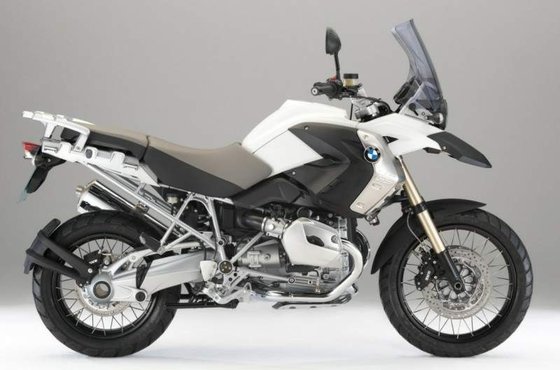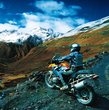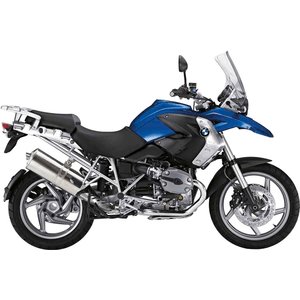BMW R 1200 GS (2006–2009): The Adventure Icon Reimagined

Introduction
The BMW R 1200 GS isn’t just a motorcycle—it’s a legend. From 2006 to 2009, this generation solidified its reputation as the ultimate "do-it-all" machine, blending long-distance touring comfort, off-road capability, and on-road agility into a single, iconic package. With its distinctive boxer engine, innovative suspension, and rugged design, the R 1200 GS became the blueprint for modern adventure bikes. Having spent time aboard this generation, I can confirm: it’s a motorcycle that feels as eager to conquer mountain passes as it does to devour highway miles. Let’s dive into why this GS remains a benchmark even today.
Riding Experience
The Heartbeat: Air/Oil-Cooled Boxer Engine
At the core of the R 1200 GS lies its 1170cc horizontally opposed twin-cylinder engine. Producing 105 hp (77 kW) at 7,500 rpm and 115 Nm (84.8 lb-ft) of torque at 5,750 rpm, this powerplant is a masterclass in versatility. The engine’s character is unmistakable—low-end grunt dominates, with torque surging from as low as 3,000 rpm.
On the road, the GS accelerates with authority. BMW’s claims of 0–100 km/h (0–62 mph) in 3.6 seconds feel conservative once you crack the throttle. The boxer’s unique vibration profile—damped by a balance shaft introduced in 2004—adds character without fatigue. By 2008, BMW tweaked the compression ratio to 12:1 (up from 11:1) and revised the camshafts, sharpening throttle response.
Off-road, the engine’s linear delivery shines. Unlike high-strung competitors, the GS’s torque curve lets you crawl over rocks or power through mud without constant gear shuffling. The shaft drive (a BMW hallmark) eliminates chain maintenance, though purists note its slight weight penalty over chain-driven rivals.
Chassis & Suspension: Telelever & Paralever Magic
The R 1200 GS’s party trick is its suspension. Up front, the Telelever system (41mm stanchions) divorces braking forces from suspension movement, eliminating dive under hard braking. At the rear, the Paralever single-sided swingarm manages shaft drive torque reactions. Together, they create a planted yet supple ride.
In 2008, BMW sharpened the steering geometry:
- Rake: 25.7° (down from 27.1°)
- Trail: 101 mm (3.97 in, reduced from 110 mm)
- Wheelbase: 1,506 mm (59.3 in)
These changes transformed the GS from a stable cruiser to a surprisingly nimble handler. On twisty tarmac, it leans into corners with confidence, while the 190mm (7.5 in) front / 200mm (7.9 in) rear suspension travel soaks up off-road abuse. Optional Enduro ESA (Electronic Suspension Adjustment) debuted in 2008, allowing on-the-fly damping adjustments—a game-changer for riders switching between terrains.
Ergonomics & Comfort
The GS’s upright riding position is sublime. The seat height ranges from 840–890 mm (33–35 in), accommodating most riders, though shorter riders may opt for a low seat (820 mm). The windscreen adjusts tool-free, and the 20L fuel tank offers a ~350 km (217 mi) range—enough for remote adventures.
Highlights:
- Wide, leverage-friendly handlebars
- Heated grips (optional) for cold mornings
- Adjustable footpegs (aftermarket kits recommended for aggressive off-roading)
Competition
The R 1200 GS dominated the adventure segment, but rivals lurked:
1. Honda Africa Twin (XRV750, 2006)
- Pros: Lighter (223 kg / 492 lbs), cheaper, iconic status.
- Cons: Aging 647cc V-twin (50 hp), chain drive, limited tech.
- Verdict: A cult classic but outgunned by the GS’s power and tech.
2. Triumph Tiger 1050 (2007)
- Pros: 1,150cc triple (123 hp), sportier on-road manners.
- Cons: Minimal off-road capability, chain drive, shorter suspension travel.
- Verdict: A tarmac-focused alternative, not a true GS rival.
3. KTM 990 Adventure (2008)
- Pros: 999cc V-twin (100 hp), aggressive off-road focus, lighter (205 kg / 452 lbs).
- Cons: Harsh seat, vibey engine, frequent chain maintenance.
- Verdict: The GS’s wilder sibling—better off-road, worse on highways.
Why the GS Won: It balanced on- and off-road prowess while offering BMW’s build quality and touring amenities. The shaft drive and optional ESA were clinchers for globetrotters.
Maintenance
Ownership costs are reasonable for a premium bike, but attention to these areas is key:
1. Valve Adjustments
- Interval: Every 10,000 km (6,200 mi)
- Specs:
- Intake: 0.10–0.15 mm (0.004–0.006 in)
- Exhaust: 0.30–0.35 mm (0.012–0.014 in)
- Pro Tip: Use MOTOPARTS.store’s NGK DCPR8EKC plugs for longevity.
2. Oil Changes
- Capacity: 4.0L (4.2 qt) with filter (SAE 15W-50, API SJ)
- Interval: 10,000 km (6,200 mi)
- Recommended: HIFLO HF164 Oil Filter
3. Shaft Drive & Final Drive
- Fluid: 180ml (6.1 oz) of 75W-90 GL-5 gear oil
- Interval: 40,000 km (24,850 mi)
4. Brake System
- Fluid: DOT 4 (replace every 2 years)
- Pads: BMW’s 4-piston calipers wear evenly but check annually.
5. Tire Pressures
- Road Use:
- Front: 2.2 bar (32 psi)
- Rear: 2.5 bar (36 psi)
- Off-Road: Drop 0.2–0.3 bar (3–4 psi) for better grip.
Conclusion

The 2006–2009 BMW R 1200 GS is a masterstroke of engineering—a motorcycle that refuses to compromise. It’s as comfortable threading through city traffic as it is crossing continents or tackling fire roads. While later models added water cooling and more tech, this generation retains a mechanical purity that enthusiasts adore.
For Owners: Keep it running smoothly with MOTOPARTS.store’s curated selection of OEM-spec oils, filters, and maintenance kits. Whether you’re prepping for a Sahara crossing or a weekend getaway, we’ve got your GS covered.
Ride far, ride often, and let the GS remind you why adventure begins at the edge of your comfort zone.












Specifications sheet
| Engine | |
|---|---|
| Stroke: | Four-stroke |
| Max power: | 77 kW | 103.0 hp |
| Max torque: | 115 Nm |
| Fuel system: | Electronic fuel injection (BMS-K digital engine management) |
| Max power @: | 7500 rpm |
| Displacement: | 1170 ccm |
| Max torque @: | 5750 rpm |
| Configuration: | Oposite |
| Cooling system: | Air/oil cooled |
| Compression ratio: | 12.0:1 |
| Number of cylinders: | 2 |
| Dimensions | |
|---|---|
| Wheelbase: | 1506 mm (59.3 in) |
| Dry weight: | 199 |
| Wet weight: | 229 |
| Seat height: | 850–870 mm (33.4–34.2 in) |
| Overall width: | 915 mm (36.0 in) |
| Overall height: | 1450 mm (57.1 in) |
| Overall length: | 2210 mm (87.0 in) |
| Ground clearance: | 165 mm (6.5 in) |
| Fuel tank capacity: | 20 L (5.3 US gal) |
| Drivetrain | |
|---|---|
| Final drive: | shaft |
| Transmission: | 6-speed manual |
| Maintenance | |
|---|---|
| Rear tire: | 150/70-17 |
| Engine oil: | 15W50 |
| Front tire: | 110/80-19 |
| Brake fluid: | DOT 4 |
| Spark plugs: | NGK DCPR8EKC, NGK DCPR8EIX |
| Forks oil capacity: | 1.3 |
| Engine oil capacity: | 4.0 |
| Gearbox oil capacity: | 0.8 L (75W-90 GL-5) |
| Final drive oil capacity: | 0.18 L (75W-90 GL-5) |
| Engine oil change interval: | Every 5000 km or 2 years |
| Valve clearance (intake, cold): | 0.15 mm |
| Valve clearance check interval: | 24,000 km (15,000 mi) |
| Valve clearance (exhaust, cold): | 0.30 mm |
| Recommended tire pressure (rear): | 2.5 bar (36 psi) solo / 2.9 bar (41 psi) with passenger |
| Recommended tire pressure (front): | 2.2 bar (32 psi) |
| Chassis and Suspension | |
|---|---|
| Frame: | Tubular space frame, engine load-bearing |
| Rear brakes: | Single 265 mm disc, 2-piston caliper (optional ABS) |
| Front brakes: | 2 x 305 mm discs, 4-piston calipers (optional ABS) |
| Rear suspension: | Paralever single-sided swingarm with hydraulically adjustable preload and rebound damping |
| Front suspension: | Telelever, 41mm stanchions, central spring strut (9-position preload adjustment) |
| Rear wheel travel: | 200 mm (7.9 in) |
| Front wheel travel: | 190 mm (7.5 in) |



















